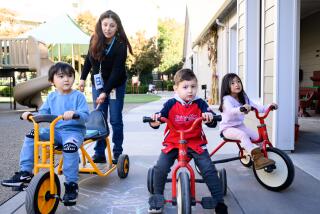Square Pegs? : Being Rejected by Peers Is Not Only Hurtful, It Can Cause Emotional Problems and Bad Behavior
- Share via
It’s the usual lively birthday bash for a bunch of 5-year-olds at a Chuck E Cheese. Children break from their parents’ grip upon arrival and race off to play together.
Except for Laurie. She doesn’t run to join her classmates. She doesn’t want her mother to leave.
Pudgy, with pigtails and a sad face, Laurie sits outside the social circle. Buddies with no one, she is quiet and clingy.
“Her social skills are light-years behind the other children,” her mother sighs, acknowledging the obvious difference in her daughter. “I don’t know what to do about it. Maybe I should hold her back a year in school.”
Laurie has been rejected by her peers. And although she feels intensely lonely, she is not alone. Millions of parents have heard the sounds of rejection: “No one plays with me.” “I don’t have any friends.”
Long dismissed as the unfortunate fate of some children, childhood educators and psychologists are becoming increasingly convinced that peer rejection represents much more than an inevitable social pecking order on school playgrounds.
Recent research suggests that peer rejection is not only hurtful, it can hamper a child’s development and even lead to long-term emotional or conduct disorders if ignored over many years.
“Being rejected in childhood truly is one of life’s most harmful experiences,” says Vivian Gussin Paley, a veteran kindergarten teacher in Chicago and author of a book on peer rejection. “A lonely child, a child who feels bad for whatever reason, will simply not concentrate on the task at hand. Each year, these children come in feeling less confident in making friends.”
Thanks to the recent attention given to peer relationships, however, there are some effective, new strategies to help almost any child fit in. But the tactics are not simple: Parents, teachers, the child and even the child’s classmates all need to help in putting a stop to the rejection.
*
Almost all parents hear their children complain about a lack of friends. But often, the child is simply upset about a single incident, such as when one of Bobby’s 20 buddies is mean to him.
The complaint should be taken seriously, however, when it’s repeated over several months, when a teacher verifies the situation or when parents simply observe that their children aren’t playing with others by the first grade, says Duke University psychologist John D. Coie, a leading authority on peer rejection.
“Sometimes it’s a transient thing. But if a child is rejected year after year by peers, that is really important,” he says.
It’s important to distinguish between children who are loners and children who are lonely because they have been rejected, Coie adds.
“Being a loner is not a problem. A lot of very competent children do things by themselves all through life. The issue is not being able to get along with peers,” he says. Usually children who don’t get along with their peers complain about it.
At any one time, an estimated 10% of children are actively excluded by their peers, studies show. But an astute teacher or parent can usually guess which children are at risk for peer rejection before it happens. These are the children who are obnoxious or bullying, shy and withdrawn or highly intelligent.
“At least half of all rejected kids also show signs of (being disruptive) in school. That is the group that has the highest rate of risk and the ones we worry about the most,” says Coie, co-editor of the book “Peer Rejection in Childhood” (Cambridge University Press, 1990).
Sometimes these children are also found to have attention deficit hyperactivity disorder, a developmental problem that causes children to be disruptive and to fail to pick up on social cues that dictate appropriate behavior.
Andrew May was a gregarious, likable toddler. But when he went to kindergarten, his boisterous behavior turned off the other kids. Andrew’s condition was eventually diagnosed as ADHD, says his mother, Kathryn May of Long Beach.
“He was excluded. He was not invited to birthday parties. And he was very angry. As a result of those things he sought approval by acting out,” says May, who founded the Long Beach chapter of the national group Children and Adults with Attention Deficit Disorders.
Because peer rejection is so common in children like Andrew, the organization CHADD has been active in promoting both individual counseling and classroom programs emphasizing good peer relationships, May says.
“A child’s entire perception of themselves is based on their ability to be accepted by their peers,” she says. “Without peer acceptance these (attention deficit) kids won’t make it.”
*
Bullying or aggressive children may not realize that no one likes them. In contrast, Coie says, extremely shy children are often aware of their social predicament.
“They probably feel the pain of rejection more,” he says. “Often, they are picked on or left out; they are the kids who are not as aggressive and do not stand up for themselves as well.”
Other studies, however, have found that withdrawn children simply fail to make an impression on peers. Rather than being overtly accepted or rejected, they are overlooked.
Another common characteristic among some rejected children is high intelligence.
Judy Hall, magnet coordinator at Canterbury School in Pacoima, was concerned about one child who was rejected year after year. But scholastic tests eventually revealed that he was exceptionally bright.
“This child was rejected in every class. He was a whiner and a crier and never would do what the other kids wanted to do. At recess, all the kids ran the other way. Ultimately, he was tested and shown to be highly gifted,” Hall says. “(Highly intelligent) kids are just not much like other kids. These kids learn to entertain themselves because no one else understands them.”
Research has found a few other intriguing clues about what makes a child popular or an outcast.
Generally, accepted kids are helpful and considerate of others and follow the rules for peer interaction. One study, for example, showed that the biggest difference between rejected children and popular children is that popular children took the time to find out what was going on in a new group situation and attempted to match their behavior to the group.
Rejected children don’t read social cues as well.
In addition, Coie believes that the way children handle their own flaws is important.
For example, while overweight children may be teased more, it’s the way they react to the teasing that can determine how they are ultimately accepted by peers. The same is true for children who are inept at games and sports. Children who respond with tears and anger will have a hard time. Children who respond good-naturedly or with humor do not have the same problem with peers, Coie says.
Having a good sense of humor has greatly helped Fred Nelson, says his mother, Lisa Marie Nelson of Agoura.
Fred is unique: He’s hyperactive, has fragile self-esteem and has unusual interests. But he doesn’t try to hide who he is.
“Fred likes bats, which other kids might think is weird,” Nelson says. “But his teacher has made a point of allowing him to show his knowledge about bats to the class. So he had a chance to impress the other kids. Things like that really help.”
Rejected children don’t need the endorsement of their entire class to gain confidence and contentment, Nelson notes. Fred is very happy with one close friend.
“He has one good friend who always sticks up for him,” she says. “We tell Fred: ‘Not everyone in the world has to like you.’ ”
Nevertheless, it’s important to help a rejected child make even small inroads as soon as possible, experts say. Even by kindergarten, Paley says, “A structure begins to be revealed and will soon be carved in stone.”
*
Studies show one of the biggest problems rejected kids have is their reputation. In one study, half the children rejected in the fifth grade continued to be rejected by their peers over the next five years.
“What this implies is that even if rejected children change their behavior, they may still have a hard time recovering,” Coie says.
But if a rejected child’s problems are not resolved in elementary school, he or she will become a teen-ager who has no source of support during the turbulent adolescent years and is at high risk for dropping out or having major social or psychological problems, Coie says.
These repercussions occur because rejected children have been repeatedly denied the chance to learn the social skills necessary to succeed in life.
Rejected children need not sacrifice their individuality or unique interests in order to fit in, experts note. Over time, rejected children often discover others with interests or personalities similar to their own.
“In high school, the curriculum is so diverse that kids often find niches for themselves and find kids with similar interests,” Coie says. “But the junior high school years can be very difficult.”
The goal for parents, counselors, therapists and teachers is to spot rejection early and intervene, experts say. When her son was rejected in kindergarten, for example, May read books on rejection then began to teach her son basic social skills.
“We role-played different situations before we went to a friend’s house while we were in the car. He hated that, but we did it anyway. And we talked about things that annoyed people,” she says. “It’s critical that the parent take an active role.”
It’s crucial to remind rejected children of their strong attributes, says John Hall, Judy’s husband. As one of Los Angeles Unified School District’s few elementary school counselors, dealing with rejection is a big part of his job.
“I talk to them about their positive side, the good pieces about them,” he says.
After dealing with the child alone, Hall often sets up small groups of children, including the rejected child, to do social skills games, such as role-playing. The outcast child often learns skills during these encounters and may regain confidence.
Studies show that if rejected children anticipate that their playmates might like them, they will behave more appropriately and may indeed become more well liked, Coie says.
But, he adds, before a child is allowed back into the peer group, the peer group has to change its bias against the child.
Because a child’s reputation among peers can become established so fast, Paley is a leading advocate of pushing children to change their attitudes toward others “who, for whatever reason, are not yet part of the system.”
In her book “You Can’t Say You Can’t Play” (Harvard University Press, 1992), Paley tells of the rule she instituted among her kindergartners that does not allow a child to be rejected from any aspect of school--including free play time.
“Children everywhere are allowed to treat each other the way no good teacher would ever treat a child,” Paley says. “But adults are ambivalent about peer rejection because we have been taught that, on this (issue), children must make up their own minds.”
With the rule in place, Paley says, the rejected children quickly gain confidence.
Parents of rejected children are eternally grateful to teachers who don’t allow a child to be shunned, May says.
“Oftentimes children can be kind and loving to someone with a visible disability, but they can be cruel and unkind to a child who has nothing visibly wrong but is being a brat,” she says. “But if children understand what another child is going through, they can be very loving and kind.”






